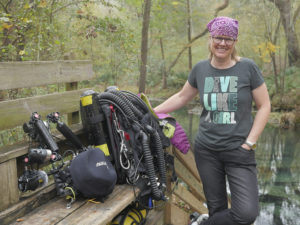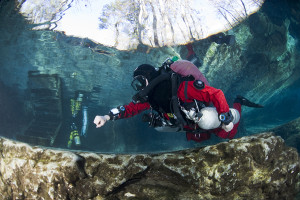 The earliest visitors to Florida knew it was a special place. Over 12,000 years ago, Paleo-Indians, perhaps following a mastodon loping through the savannah, were drawn to bountiful turquoise water holes in the woods. In those days, glaciers to the north had not yet melted, and the Florida peninsula was much more extensive and drier than it is today. Surface waters like rivers and lakes were scarce and the indigenous people survived by finding places where nourishing waters welled up from underground. Like an oasis in the desert, springs were sanctuaries, attracting humans and animals to share their sustaining bounty. Today, these watery jewels attract tens of thousands of visitors and new residents to Florida’s hidden coastlines.
The earliest visitors to Florida knew it was a special place. Over 12,000 years ago, Paleo-Indians, perhaps following a mastodon loping through the savannah, were drawn to bountiful turquoise water holes in the woods. In those days, glaciers to the north had not yet melted, and the Florida peninsula was much more extensive and drier than it is today. Surface waters like rivers and lakes were scarce and the indigenous people survived by finding places where nourishing waters welled up from underground. Like an oasis in the desert, springs were sanctuaries, attracting humans and animals to share their sustaining bounty. Today, these watery jewels attract tens of thousands of visitors and new residents to Florida’s hidden coastlines.
What makes Florida’s springs so unique among the world’s aquatic wonders is not what you see; it’s what you don’t. Much of Florida’s water flows underground through a dark and uncharted geologic wilderness. Every drop of freshwater flowing out of Florida’s springs originates in a vast subterranean reservoir known as the Floridan Aquifer – the water source for more than 60 percent of Florida’s residents. This aquifer system underlies a region covering 100,000 square miles in southern Alabama, southeastern Georgia, southern South Carolina, and Florida.
 Below ground, water flows through voids in the sponge-like limestone as well as in between tiny grains of sand, generally from higher elevations to lower ones. Drifting down gentle slopes in the landscape, the water can flow slowly. Where steeper inclines are present, the underground rivers flow with rapid erosive force, creating enormous water-filled voids and tunnels. These large passages have lured a unique breed of explorers and adventurers who swim through the vaulted spaces—cave divers.
Below ground, water flows through voids in the sponge-like limestone as well as in between tiny grains of sand, generally from higher elevations to lower ones. Drifting down gentle slopes in the landscape, the water can flow slowly. Where steeper inclines are present, the underground rivers flow with rapid erosive force, creating enormous water-filled voids and tunnels. These large passages have lured a unique breed of explorers and adventurers who swim through the vaulted spaces—cave divers.
With virtually every corner of the globe known, mapped, and in one way or another, harnessed for human use, the hidden wilderness in north Florida is still a place of great mystery. Highly trained cave explorers have the unique privilege to swim into the branches of the aquifer gathering knowledge that may one day aid in restoring Florida’s springs to their once pristine state.
Springs are not just the realm of the brave cave diver. Springs offer casual observers unique locations to swim, camp, snorkel, scuba dive, and observe local wildlife. During the day, picnickers can stroll along nature trails or swim in the clear, refreshing headsprings. Beneath the surface, springs support a unique and diverse freshwater ecosystem. With a mask, snorkel, and fins, people can explore this world, seeing fish, manatees and unique underwater plants. At night, under a canopy of stars and enveloped in a symphony of tree frogs and crickets, campers can have the springs to themselves, as it might have been for Florida’s first residents ten thousand years ago.
 North Florida holds some of the best-kept secrets and wilderness adventures available to visitors. The hidden interior coastlines were attractive to the first settlers of the region and continue to lure people such as myself into calling this region a heartfelt home.
North Florida holds some of the best-kept secrets and wilderness adventures available to visitors. The hidden interior coastlines were attractive to the first settlers of the region and continue to lure people such as myself into calling this region a heartfelt home.
Next time you visit north Florida, get beyond the Disney parks and drive to Crystal River to swim with the manatees. Go tubing down the river at Ichetucknee Springs State Park or snorkel in the Rainbow River.
http://www.BirdsUnderwater.com
https://www.floridastateparks.org/parks-and-trails/ichetucknee-springs-state-park
https://www.floridastateparks.org/parks-and-trails/rainbow-springs-state-park
To learn more about my adventures cave diving in North Florida, please pre-order my memoir Into The Planet, to be released on August 27, 2019, online and through booksellers everywhere.
